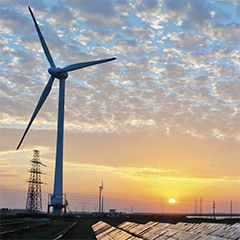The energy transition is shifting national agendas and is cutting across all industries and markets. As a global hub for innovation, Singapore has built a vibrant ecosystem to advance today’s efforts on energy and climate change. With South East Asia’s energy demand forecasted to grow by 50% by 2050, alternative energy sources need to be explored quickly to move on the decarbonization pathway.
Transforming our energy systems
First, the energy transition will bring large changes to South East Asia’s energy system in the next thirty years. Fossil fuels will continue to play a dominant role in the region’s energy supply, which will see gas continue to increase. Solar PV and wind will both record strong growth as a result of the massive rise in end user electrification and the electrification of vehicles and industry. Renewables development will also expand offshore.
Building momentum
Second, Singapore’s energy journey highlights how governments can play a key role in accelerating the energy transition towards more sustainable energy sources while maintaining energy security and affordability. The Singapore energy strategy rests on four pillars which are comprised of:
1. Natural gas: while natural gas will remain as Singapore’s dominant fuel, the government is helping power generation companies improve the efficiency of their power plants.
2. Solar energy: the Singapore government is ramping up solar energy production in the country by setting ambitious solar targets of 1.5 gigawatt-peak (GWp) by 2025, 2GWp by 2030 and an energy storage target of 200 MW beyond 2025.
3. Regional power grids: Singapore is exploring ways to tap on regional power grids to access
cost-competitive renewable energy produced in other markets.
4. Emerging low-carbon alternatives: Singapore is also looking into emerging low-carbon solutions through public-private partnerships that have the potential to help reduce Singapore’s carbon footprint. These technologies include carbon capture, utilization and storage (CCUS) technologies and hydrogen.
Elsewhere in South East Asia, energy ministers agreed last year to set a target of 35% in installed power capacity by 2025 to improve the renewable energy capacity in the region, take advantage of RE’s lower costs and stimulate their pandemic-hit economies. This agreement paves the way for an additional 35 to 40GW of renewable capacity by 2025.
Vietnam currently leads the region in renewables. Vietnam today has an installed base of 16.5 gigawatts for solar PV, far exceeding its 2020 target of 850 MW. Its success in solar has been largely attributed to its feed-in-tariff program for renewable energy. Aside from solar PV, Vietnam’s energy transition includes investments in wind, hydropower and biopower.
In June 2020, the Vietnamese government formally approved 7 gigawatts or almost a hundred new wind power plants, putting it on track for a total wind power generation capacity of nearly 12 GW by 2025. Under the National Power Development Plan 2021-2030, the government plans to build 50 GW in power capacity from onshore and offshore wind and solar energy by 2030.
In Thailand, the government aims to source at least a third of the country’s power requirements from renewable sources by 2037 under the 10-year Alternative Energy Development Plan. Solar is expected to dominate with a capacity of 15 GW, followed by biomass, wind, hydropower and waste energy.
State-run Electricity Generating Authority of Thailand said a portion of their new capacity will be sourced from renewable power generation facilities in Taiwan and Laos. They own 25% of Yunlin Holding GmbH, which is developing the 640MW Yunlin offshore wind farm project in Taiwan.
In Malaysia, the government intends to continue the good progress they’ve made with a target to increase RE’s share in the energy mix to 20% by 2025. To minimize the financial impact of the pandemic on the economy, the government issued a 1GW solar tender this past June under the fourth round of its Large Scale Solar (LSS) programme.



























